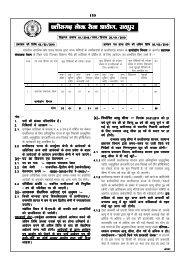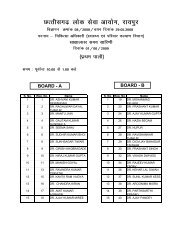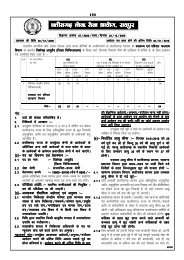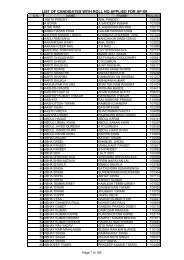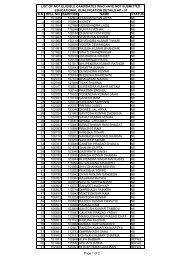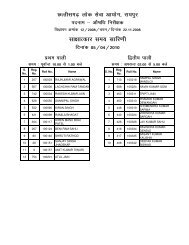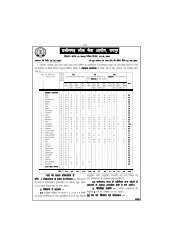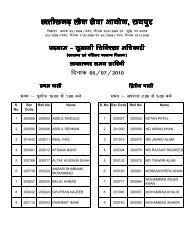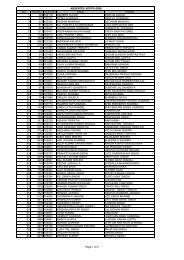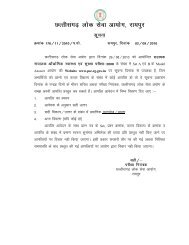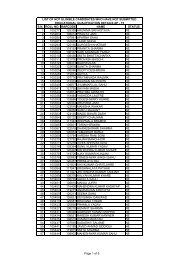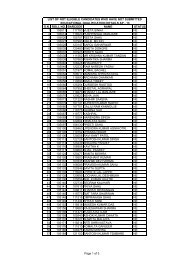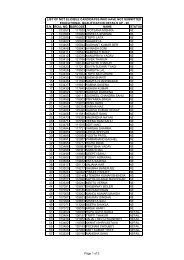to view / print advertisement (from 28/12/2011) - Chhattisgarh Public ...
to view / print advertisement (from 28/12/2011) - Chhattisgarh Public ...
to view / print advertisement (from 28/12/2011) - Chhattisgarh Public ...
Create successful ePaper yourself
Turn your PDF publications into a flip-book with our unique Google optimized e-Paper software.
11. HISTORYPAPER - IIndian His<strong>to</strong>rySection - A(17)1- Sources and approaches <strong>to</strong> the study of AncientIndian His<strong>to</strong>ry.2- Early pas<strong>to</strong>rial and agricultural communitieswith reference <strong>to</strong> mesolithic and neolithic periods.3- Harappan Civilization - origin, the Maturephase, extent, society, economy and culture, majorthoughts regarding decline, post- Harappancultures.4- Vedic Civilization - Vedic literature, changes inreligion, social system, polity and economy <strong>from</strong>the Rigvedic <strong>to</strong> Later Vedic period, Upanishadicthoughts.5- Jainism, Buddhism and other sects, secondphase of urbanization, political condition of northernIndia in 6th Century B.C., rise of Magadhempire.6- The Mauryan Age - expansion of empire,Ashokan edicts and his Dhamma, socio-economicconditions and cultural development.7- Northern and Penisular India during Post-Mauryan period- Indo-Greek, Saka, Parthian,Kushana, Sunga and Satawahana dynasties, society,economy and culture, Sangam culture.8- The Vakataka- Gupta Age- important rulers,administrative system, socio-economic conditions,development of literature, Science and art.9- Post-Gupta period-Chalukaya, Pallava,Vardhan. Pala, Rashtrakuta and chola dynasties,development of feudal system.10- Origin of Rajputs, principal Rajput dynasties,social stratification, temple architecture andeconomy.Section - B1- Sources of Medieval Indian His<strong>to</strong>ry.2- Arab invasion on sind, invasions of MahmudGhazni and Muhammad Ghori on northern Indiaand their effects.3- Delhi Sultanate - establishment of Sultanate underQutubuddin Aibak, Iltutamish and Balban, theKhalji imperialism and administrative system, policesand administrative principles of Muhammadbin Tughlaq and Ferozeshah, Sayyid and Lodi dynasties.4- Economy and culture during the Sultanate period- agriculture, trade and commerce, the BhaktiMovement, Sufism, architecture, art and socialsystem.5- Vijaynagar and Bahamani empires - polity andculture.6- Babar, Humayun and Shershah - Vic<strong>to</strong>ries ofBabar, Humayun's failures, second Afghan empireunder Shershah, Shershas's administrative andland revenues reforms.7- Akbar - establishment of Mughal Empire, concep<strong>to</strong>f monarchy, administrative and land revenuesystems, religious and Rajput policies.8- Age of Jahangir and Shahjahan.9- Arungazeb - climax of Mughal Empire, religiouspolicy, Deccan policy, major revolts and disintegrationof empire.10- Rise of the Marathas - Shivaji, expansion ofkingdom, administration and land revenue system.11- Mughal administration, Social, economic andcultural conditions during mughal period.<strong>12</strong>- Decline of Mughal empire - Later Mughals,rise of Maratha power under the Peshwas, Provincialkingdoms with special reference <strong>to</strong> Bengal,Awadh and the Nizam.Section - C1- Establishment of British rule in India - AngloFrench struggle, British relations with Mysore andthe Marathas.2- Expansion of British empire <strong>from</strong> 1798 <strong>to</strong> 1856- policies of Lord Wellesley, Lord Hastings, LordWilliam Bentinck and Lord Dalhousie, consolidationof empire.3- The Upheaval of 1857 - causes, nature andeffects.4- India under British crown - Queen Vic<strong>to</strong>ria'sproclamation, administrative and fiscal decentralization,Ripon's Liboralism and curzon's imperialism.5- Social and Religious Movements - the BrahmoSamaj, the Parathana Samaj, the Arya Samaj,Aligarh Movement, Ramakrishna Mission and theTheosophical Society.6- Colonial Economy - Taxation, Drain of wealth,land revenue settlements, decay of handicraft industries,transport and communications, developmen<strong>to</strong>f modern industries, commercialization ofagriculture and rural indebtedness.7- Rise and Development of Indian Nationalism -establishment of Indian National Congress, Moderatesand extremists in the Congress, theSwadeshi Movement, revolutionary movementsand Home Rule Movement.8- Freedom Struggle - Non-Co-operation movement,Civil Disobedience movement, Individualsatyagraha, Quit India movement and Indian NationalArmy.9- Towards Independence - the Simla Pact, theInterim Govt., the Mountabatten Plan, Partitionof India and transfer of power, integration of IndianStates.10- Constitutional Development of India. Act of1858, 1861, 1892, 1909, 1919 and 1935, formationof Indian constitution and salient featuresof the constitution.PAPER - IIHis<strong>to</strong>ry of Modern World.1- Industrial Revolution - Revolution in England,industrialization in USA, Germany, France and Japan,rise of capitalism and imperialism, Socialismand working class movements.2- War of American Independence - causes,events and results.3- French Revolution - causes, contribution of thephilosophers, National Assembly, National Convention,Girondists and Jacobins, Reign of Terror,impact of revolution.4- Age of Napoleon - rise of Napoleon internalreforms and foreign policy as first Consul, continentalSystem. Peninsular War, Russian campaignand downfall.5- Age of Reaction - The Congress of Vienna,the Concert of Europe, July Revolution of 1830,Revolution of 1848 and fall of Metternich.6- Unification of Italy - rise of nationalism, establishmen<strong>to</strong>f Carbonari, Mazzini, Cavour andGaribaldi, acquisition of Venetia (1866) and Rome(1870).7- Unification of Germany - establishment ofZollverein, rise of Bismarck, problem of Schleswig- Holstein and war with Denmark (1864), Astro-Prussian War (1866) and Franco - Prussian War(1870).8- Emergence of Japan as a Power - Meiji Res<strong>to</strong>ration,Industrialization and Westernization,Sino-Japanese War (1894-95) and Russo-JapaneseWar (1904-05).9- Liberalism in Great Britain - Parliamentary reforms,Chartist Movement, economic, educationaland industrial reforms.10- American Civil war - causes, election ofAbraham Lincoln as President, separation ofsouthern states, civil war, end of slave system, consequences.11- The Eastern Question - Greek War of Independence,the Crimean War, Congress of Berlin,the Young Turk Movement and Balkan wars.<strong>12</strong>- European interests in China - the opium wars,extra-terri<strong>to</strong>rial rights, Tai-ping Rebellion, BoxerUprising, the Revolution of 1911.13- First World War - causes, events and consequences.14- Paris Peace Conference and the League ofNations - the Big Four, the Paris Peace Treatiesachievements and failures of the League of Nations.15- The Russian Revolution of 1917 - causes,events and impact.16- Rise of Totalitarian regimes in Italy, Germanyand Japan - Mussolini, Hitler, Militarism in Japan.17- Nationalism in Indonesia and Indo-china -rise of nationalism in Indonesia, various politicalorganizations and their activities, Ho-chi Minh andnationalism in Indo-China.18- Communism in China - Chiang Kai-Shek andChinese Nationalism, Communist Revolution of1949 under Mao Tse Tung and its impact.19- Arab Nationalism - Manda<strong>to</strong>ry System in theMiddle East, nationalism in Egypt, Iraq, Syria, andLebanon and the Palestinian Problem.20- Second World War - causes, events and results.Øe'k%



